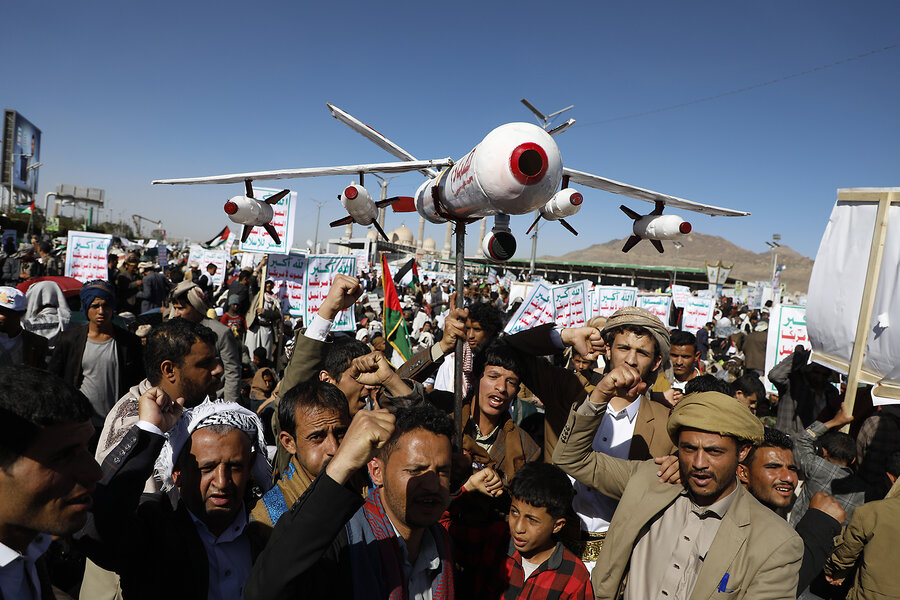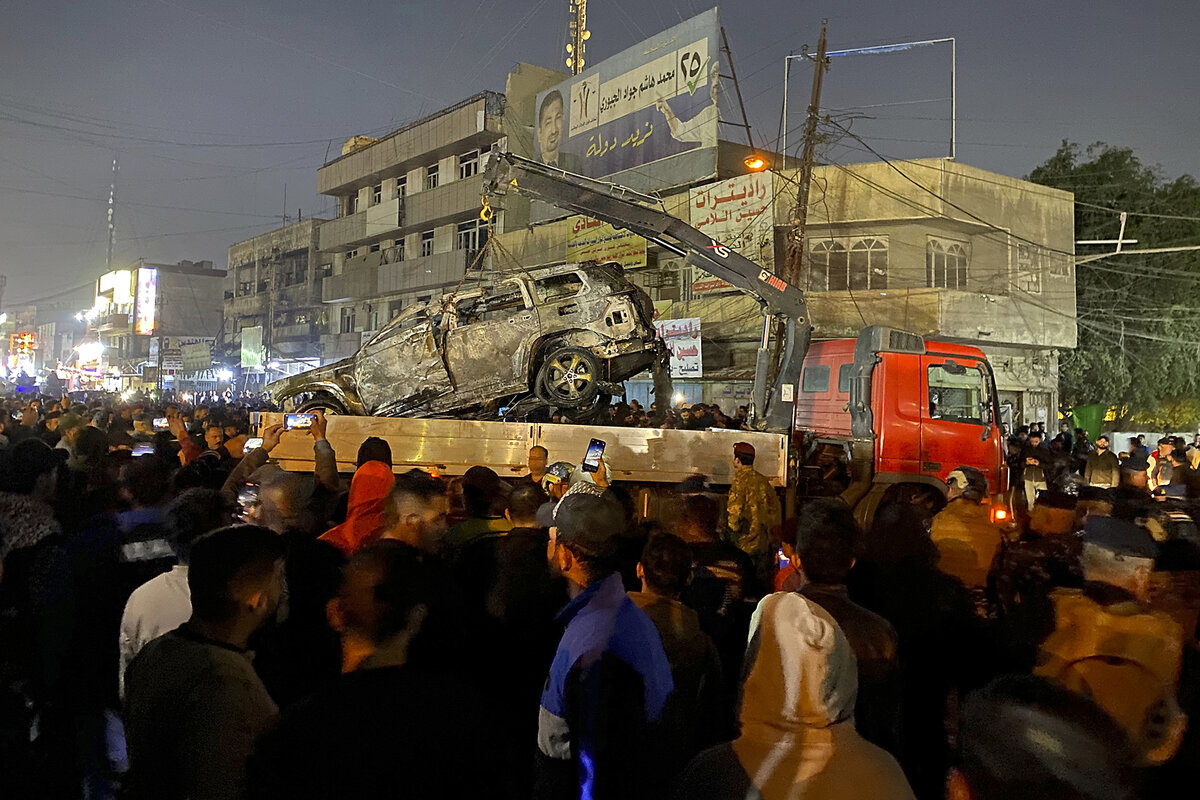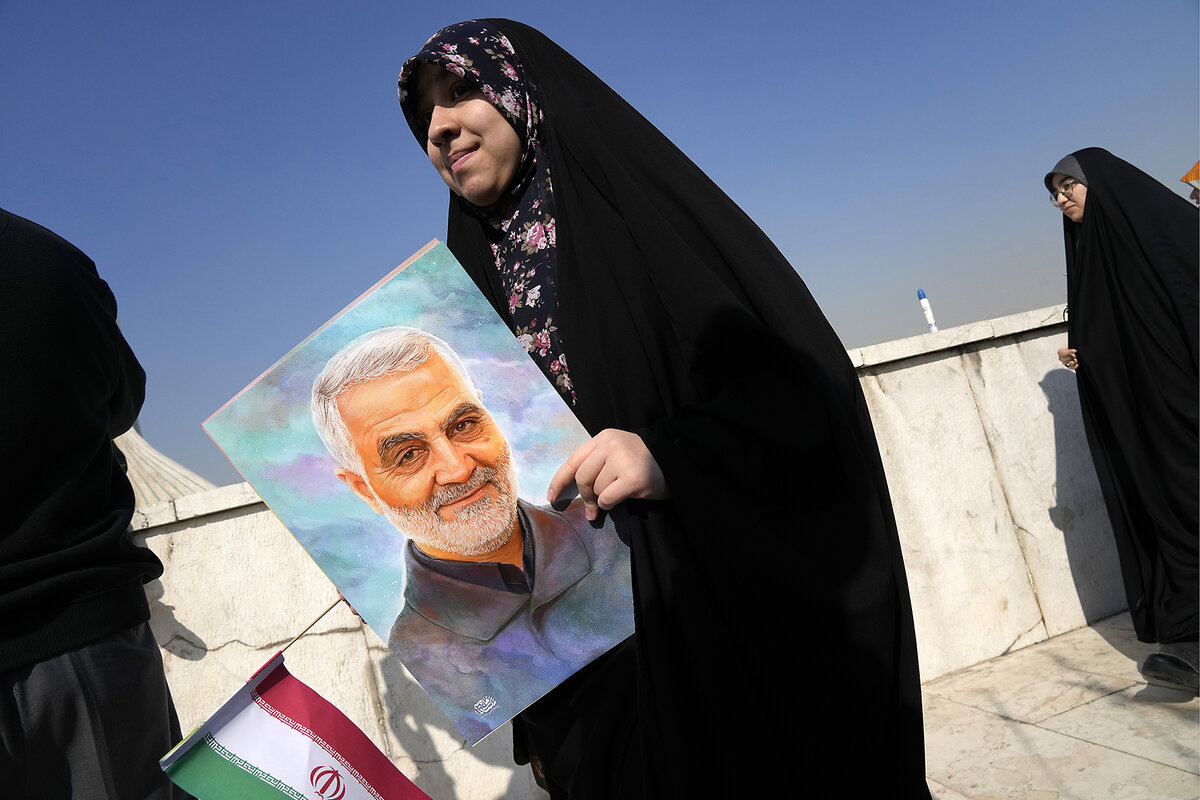Does US deterrence work against Iran’s allies? Yes and no.
Loading...
| LONDON
For more than six weeks, there have been no attacks by Iran-allied militias against U.S. forces in Iraq or Syria.
As the Israel-Hamas war in Gaza spilled across the Middle East in October, American troops deployed in those countries to quell the Islamic State came under fire repeatedly.
Iran-backed militias fired on U.S. forces in solidarity with Hamas, a fellow member of Tehran’s “Axis of Resistance” alliance against Israeli and American interests in the region.
Why We Wrote This
A story focused onSince war erupted in Gaza, U.S. forces and interests in the Middle East have come under fire from allies of Iran. The challenge has been to deter these attacks and prevent the conflict from escalating, but the U.S. record is uneven.
Some 180 such attacks at first elicited a limited U.S. response, as Washington sought to avoid a direct confrontation with Iran.
But when a drone strike by Kata’ib Hezbollah, an Iraqi Shiite paramilitary group, killed three Americans on Feb. 3 on Jordan’s border with Syria, the United States escalated mightily and precisely in a bid to deter further attacks.
American warplanes struck 85 Iran-backed militia targets. Then, on Feb. 7, a U.S. drone in Baghdad destroyed a vehicle – with no collateral damage – carrying the Kata’ib Hezbollah officer who had handled logistics for the deadly attack in Jordan.
The anti-U.S. attacks in Iraq and Syria stopped.
So why has deterrence worked – even if only temporarily – against Iran-backed militias in those countries?
And why, in contrast, have more than two months of U.S.-led airstrikes against the Iran-backed Houthis in Yemen so far failed to halt rocket and drone attacks against shipping through the Red Sea?
“What really shook them up [the militias and the Iranians] was the targeted killing of the logistics commander in Baghdad,” says Kenneth Katzman, a veteran Middle East analyst and senior fellow at The Soufan Center, a global intelligence and security consultancy in New York.
The strike, he says, was proof of exceptionally precise locational intelligence. He adds that it “showed that the U.S. is willing to employ the same strategy it used on Al Qaeda and the Islamic State – a targeted killing strategy that … convinced” the militias and Iran “that Washington is going to use all elements of its intelligence and capabilities to go after them if they continue.”
Since the eruption of the Hamas-Israel war, Tehran and Washington have both made clear their desire to prevent the regional spillover from triggering a direct conflict between them.
One result is that, after the death of the Americans in Jordan, Kata’ib Hezbollah publicly complained that Iran pressured it to stop attacks against U.S. troops. The commander of Iran’s Qods Force – the wing of the Revolutionary Guard that manages Iran-backed “Axis” militias across the region – specifically ordered the militias to stand down.
Another result is that soon after an escalation this month between Israel and “Axis” member Hezbollah in Lebanon, Hezbollah said it had already informed Qods Force chief Brig. Gen. Esmail Qaani it would fight Israel alone – without Iran – if Israeli actions precipitated an all-out war with Hezbollah.
Delicate calculations
Few analysts think Iran would stay out of a fight that jeopardized its most powerful proxy force, but Hezbollah’s careful public messaging shows how delicate calculations of deterrence and escalation may be.
“The killing of the U.S. soldiers pulled the rug from beneath the Iranians’ own feet, because it exposed them by forcing the Americans to respond more forcefully,” says Julien Barnes-Dacey, director of the Middle East and North Africa Program at the European Council on Foreign Relations.
“Up until that point you had a degree of calibrated, ongoing Iranian attacks against U.S. assets that didn’t quite cross the line of fatalities, that allowed Tehran to put pressure on the U.S. without forcing an unwilling Biden administration to get sucked into a response of their own,” says Mr. Barnes-Dacey.
“It’s a fragile calm in Iraq and Syria at the moment, and it would be a pretty brave bet to suggest that U.S. deterrence has been established in a sustainable fashion,” he says. “There is a holding pause in conflict between the two at the moment, but I’m not sure of the extent to which Iran will hold its fire and will take other hits – whether from the U.S. or the Israelis – without feeling compelled to reinitiate its own attacks.”
Iran has significant influence over Shiite militias in Iraq and Syria, those most loyal to the Islamic Republic, such as Kata’ib Hezbollah, because it largely created them. It has far less influence in Yemen, where the Houthi movement was well-established and had successfully captured the capital, Sanaa, before Iran significantly boosted the their arsenal of missiles and armed drones.
Iran also has its own bitter experience with a U.S. targeted killing. The Qods Force commander and creator of the “Axis of Resistance,” Maj. Gen. Qassem Soleimani, was assassinated in a drone strike in Baghdad in 2020.
“That tactic has scared the Iranians, and the [Axis] militias,” says Dr. Katzman of The Soufan Center. “What I am surprised at is that it hasn’t scared the Houthis, because they’re in line for the same treatment if they continue the way they are going. There are definitely calls for targeted strikes on Houthi leaders in Washington – that is very clear.”
Are Houthis undeterrable?
Indeed, despite the U.S.-led bombing campaign to thwart Houthi attacks on Red Sea shipping since Jan. 12, continued Houthi resistance – including one cargo ship sunk and another set ablaze in recent weeks – in declared solidarity with the Palestinians has resulted in a surge in their status and influence at home and abroad.
Analysts say the Houthis are largely undeterrable after prevailing militarily over Saudi Arabia, despite a years-long bombing campaign. And Iran has limited interest in reining in the Houthis – even if it could – because their efforts are tying up U.S. forces and focusing attention on Gaza.
Dr. Katzman notes that the U.S. agreed to discuss its presence in Iraq with the Baghdad government, enabling Iraqi leaders to argue that militia attacks against the Americans would likely only prolong a U.S. military role – and giving Iran an incentive to pressure its militia allies. The same does not apply in Yemen.
“The Houthis don’t feel they owe Iran that much,” he says. “Iran didn’t create the Houthi movement. Iran wasn’t supporting them when they took over Sanaa. Iran came in very late to the party.”
Nevertheless, a “concerted” U.S. military effort to strike Houthi ground weapons could have an effect, Dr. Katzman adds.
“The U.S. Air Force can do more damage in one hour than the Saudi Air Force can do in eight years,” he says. “It would cause them to hunker down, even if they are not totally deterred. If you do find them and do get one or two of these leaders, that has an effect, too.”








